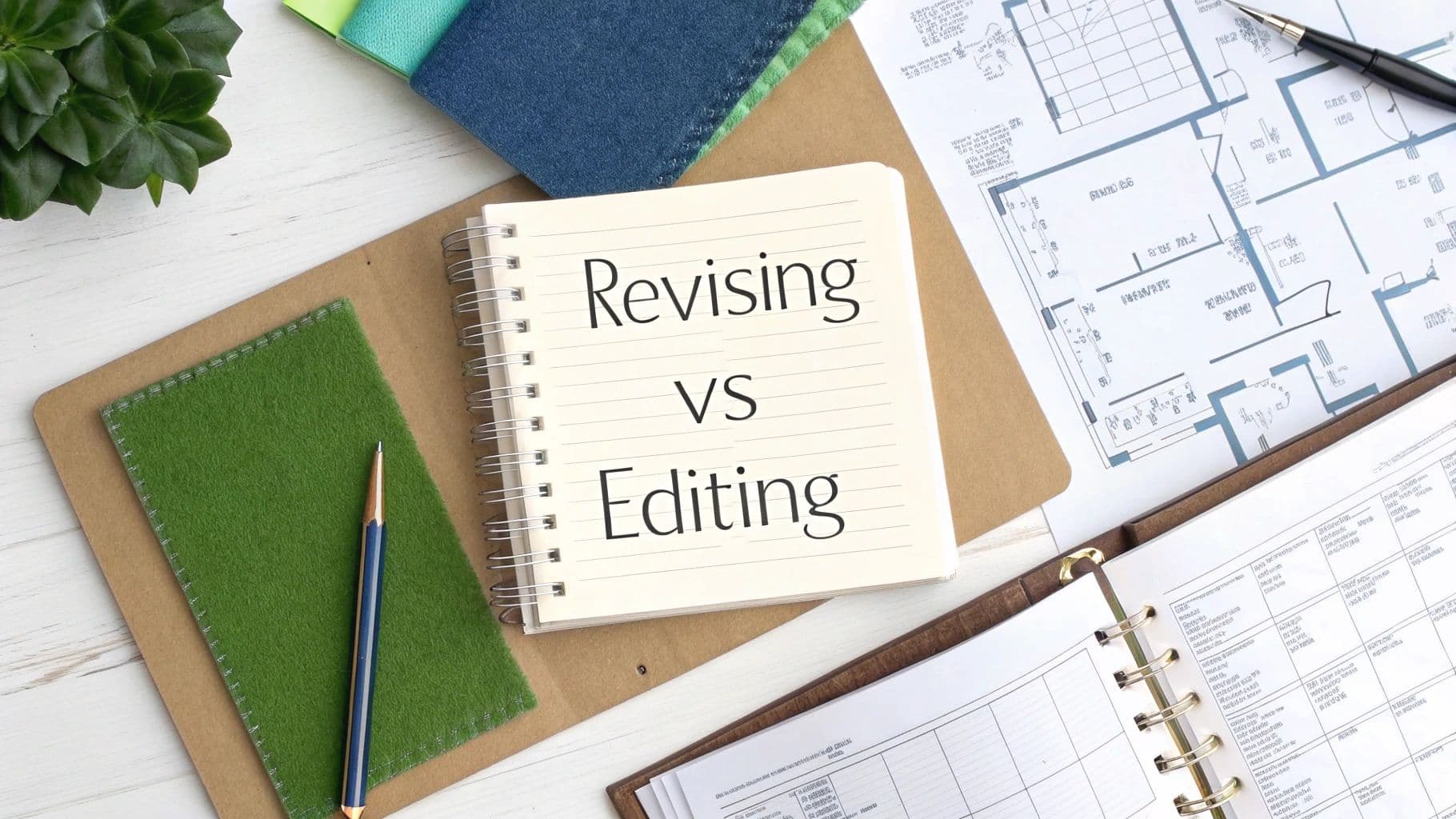
7 Good Closing Transition Words to Use in 2025
September 18, 2025
The perfect ending can transform a good piece of writing into a great one. It's the final impression you leave, the thought that lingers with your reader long after they've finished. But how do you signal that powerful conclusion without resorting to the same tired phrases? The key lies in choosing the right closing transition words. These small but mighty phrases guide your reader to a satisfying finish, adding clarity, authority, and style. This guide will explore seven of the most effective and good closing transition words, breaking down when and how to use them to make your conclusions resonate.
We'll move beyond the basics, offering fresh perspectives on how to end your arguments, reports, and essays with confidence and impact. Ultimately, the goal of using these words is to create content that resonates. For broader strategies on how to create engaging content that gets results, you can explore this guide. Let’s dive into the specific phrases that will elevate your writing.
1. In conclusion
"In conclusion" is perhaps the most direct and widely recognized of all good closing transition words. It acts as a formal signpost, explicitly telling your reader that you are about to summarize the main arguments and present your final thoughts. This phrase creates a clear, unambiguous boundary between the body of your text and its concluding remarks.

Its directness makes it exceptionally well-suited for academic papers, formal reports, and professional presentations where clarity is paramount. By using "In conclusion," you leave no doubt about your intention, guiding your audience to the final takeaway.
When to Use "In conclusion"
This phrase is most effective in structured, formal writing. It signals a shift from providing evidence to synthesizing that evidence into a final, cohesive statement.
- Academic Essays: Use it to start the final paragraph that restates your thesis and summarizes key supporting points.
- Business Reports: It works perfectly to introduce the executive summary or the final recommendations section.
- Formal Speeches: It verbally cues your audience that you are wrapping up, helping them focus on your core message.
Actionable Tips for Implementation
To maximize its impact, use "In conclusion" strategically. Overuse can make your writing feel formulaic, but in the right context, its power is unmatched. For a deeper dive into structuring your final thoughts, explore this guide on how to write a conclusion paragraph.
Pro-Tip: Follow "In conclusion" with a concise restatement of your main points, not new information. Its job is to summarize what you've already discussed, solidifying your argument in the reader's mind.
2. Ultimately
"Ultimately" is a sophisticated transition word that signals the final, most important consideration after weighing all factors. It implies that your conclusion represents the fundamental truth or most significant outcome, adding a layer of depth and authority to your final statement. This makes it a powerful choice for persuasive essays and complex arguments where multiple viewpoints have been discussed.

Unlike more direct phrases, "ultimately" suggests a thoughtful evaluation process has occurred. It tells the reader you have considered various elements and are now presenting the core, decisive point. This makes it one of the more compelling good closing transition words for building a convincing final argument.
When to Use "Ultimately"
This word is most effective when you have explored different facets of a topic and need to distill them into a single, conclusive thought. It’s perfect for showing that you’ve reached a final judgment.
- Persuasive Essays: Use it to introduce the concluding statement that solidifies your primary argument after analyzing counterarguments.
- Case Studies: It works well to present the final, most critical lesson or takeaway derived from the analysis.
- Opinion Pieces: It helps emphasize your definitive stance on a complex issue after acknowledging its nuances.
Actionable Tips for Implementation
To use "ultimately" effectively, ensure it introduces a conclusion that logically follows a balanced discussion. Its strength lies in resolving complexity, not just ending a paragraph.
Pro-Tip: Reserve "Ultimately" for your single most important takeaway. Following it with your strongest, most impactful argument gives your conclusion a sense of finality and weight that resonates with the reader.
3. In summary
"In summary" is a clear, professional transition phrase that signals a condensed restatement of your main points. It strikes a balance between formal and casual, making it one of the best good closing transition words for business communications and informational writing.

By using "In summary," you give readers a structured cue that you are wrapping up. It prepares them for a brief, digestible recap without the rigidity of "in conclusion" or the informality of “to wrap up.” This transition enhances readability and ensures your audience leaves with the key takeaways front of mind.
When to Use "In summary"
- Business Emails: Recap 2–4 critical findings or action items
- Reports and Proposals: Introduce a bullet list of your top recommendations
- Academic Handouts: Highlight essential concepts for quick review
- Blog Posts: Offer readers a clean, easy-to-scan conclusion
Actionable Tips for Implementation
- Follow with bulleted or numbered points whenever possible
- Keep each recap point short and focused
- Limit yourself to the 2–4 most important ideas
- Avoid rehashing every detail from earlier sections
Pro Tip: Use "In summary" before a crisp list of points. This approach guides the reader directly to your core insights without overwhelming them with extra information.
4. Therefore
"Therefore" is a powerful and logical transition word that signals a conclusion derived directly from preceding evidence or reasoning. It establishes a clear cause-and-effect relationship, telling the reader that what follows is the natural, logical result of the information you have just presented. This makes it an essential tool for argumentative, analytical, and persuasive writing.

Unlike more general closing phrases, "Therefore" carries the weight of logic. Using it implies that you have built a solid case and are now presenting the inevitable conclusion. Its formal tone and logical precision make it a favorite in academic, scientific, and professional contexts where arguments must be supported by evidence.
When to Use "Therefore"
This transition word is most effective when your conclusion is a direct and undeniable consequence of the points you have just made. It shines in writing that depends on logical progression.
- Scientific and Research Papers: Use it to state a conclusion drawn from data or experimental results. For example: "The experiment showed consistent results across all trials; therefore, we can conclude the hypothesis is supported."
- Argumentative Essays: It is perfect for linking your evidence to your final claim, reinforcing the strength of your argument.
- Business Proposals: Employ it to connect a problem or data point to your proposed solution. For instance: "Sales have declined for three consecutive quarters; therefore, we need to revise our marketing strategy."
Actionable Tips for Implementation
To use "Therefore" effectively, the logical link between your evidence and conclusion must be unbreakable. Misusing it can weaken your credibility. To ensure your arguments are sound, consider exploring these 8 effective writing strategies.
Pro-Tip: Before using "Therefore," ask yourself: "Does B logically follow from A?" If the connection is weak or assumed, choose a different transition. The strength of "Therefore" lies in its undeniable logical connection.
5. Finally
"Finally" is a versatile and powerful transition word that signals the last item in a sequence or the ultimate outcome of a process. It provides both chronological and logical closure, telling the reader that the journey through your points has reached its definitive end. This phrase carries a sense of culmination and weight, making it impactful.
Its dual function allows it to fit seamlessly into narratives, arguments, and instructions. By using "Finally," you create a sense of anticipation and satisfaction, emphasizing that the concluding point is the most important or the last piece of the puzzle. This makes it one of the most effective good closing transition words for adding emphasis.
When to Use "Finally"
This phrase is best used when you want to underscore the last point in a series or present a climactic conclusion. It works well in both formal and informal writing, adding a touch of drama or finality.
- Persuasive Essays: Use it to introduce your most compelling argument or the ultimate concluding thought that ties everything together.
- Narratives or Stories: It can signal the resolution of a long journey or process, as in, "After months of searching, he finally found the answer."
- Numbered or Sequenced Arguments: It provides a clear and satisfying end to a list, especially after using "first," "second," etc.
Actionable Tips for Implementation
To use "Finally" effectively, ensure it genuinely introduces your last point to avoid confusing the reader. Its impact comes from its position as the concluding thought. For more ideas on concluding your writing with impact, check out this guide on good transition words for a conclusion.
Pro-Tip: Position "Finally" to introduce the most significant or awaited piece of information. For example: "The research examined multiple factors. Finally, it confirmed the primary cause." This placement gives your final point the prominence it deserves.
6. In short
"In short" is a concise closing transition phrase that promises brevity while delivering the essential message. It signals to your reader that you are about to distill a complex or lengthy discussion into its most important, core elements. This phrase is perfect for audiences who value quick comprehension.
Using "In short" builds trust by showing you respect your reader's time. It effectively says, "I've presented the details, but here is the single most important thing you need to remember." This makes it an invaluable tool in professional and informational writing where clarity and efficiency are key.
When to Use "In short"
This phrase is most powerful when used to summarize genuinely complex information. It serves as a bridge from detailed analysis to a simple, memorable takeaway, making it one of the most practical good closing transition words.
- Executive Summaries: Use it to quickly recap extensive data before making a recommendation. Example: The market analysis reveals multiple factors affecting consumer behavior. In short, price remains the primary decision driver.
- Complex Explanations: It helps clarify a difficult concept by reducing it to its fundamental point. Example: The legal implications are numerous and complicated. In short, we need expert consultation before proceeding.
- Meeting Recaps: It is ideal for summarizing long discussions into actionable conclusions. Example: After extensive deliberation about various approaches, in short, we recommend the hybrid model.
Actionable Tips for Implementation
To use "In short" effectively, ensure the summary that follows is truly brief and captures the essence of the preceding text. Its purpose is to provide a quick, high-impact summary, not to introduce new ideas or arguments.
Pro-Tip: Reserve "In short" for situations where the information you're summarizing is genuinely detailed or multifaceted. Using it after a simple point can feel redundant and diminish its impact. The power of this phrase lies in its ability to simplify complexity.
7. All things considered
"All things considered" is a thoughtful transition phrase that signals a conclusion reached after weighing multiple factors. It implies a balanced assessment, showing your reader that you have acknowledged complexity and nuance before arriving at your final position. This phrase conveys that the conclusion isn't a simple one but a deliberate judgment.
Its strength lies in its ability to build credibility. By using "All things considered," you communicate that you've examined various perspectives, potential drawbacks, or competing data points. This makes your final statement feel more reasoned, measured, and persuasive, positioning you as a careful and analytical thinker.
When to Use "All things considered"
This phrase is ideal for analytical writing where you have presented a multifaceted argument. It works best when you need to synthesize conflicting information into a single, decisive takeaway.
- Persuasive Essays: Use it to conclude after discussing counterarguments, showing you have considered and accounted for opposing views.
- Decision-Making Reports: It’s perfect for introducing a final recommendation after evaluating various pros and cons.
- Performance Reviews: It can soften a concluding judgment by acknowledging a mix of strengths and areas for improvement.
Actionable Tips for Implementation
To use this phrase effectively, ensure the body of your text genuinely explores different angles. It loses its impact if you haven't presented multiple sides for the reader to consider.
Pro-Tip: Follow "All things considered" with a nuanced but clear conclusion. The phrase sets up a sophisticated argument, so your final statement should reflect that thoughtful deliberation rather than an oversimplified summary.
Comparison of 7 Closing Transition Words
| Transition Phrase | 🔄 Implementation Complexity | 💡 Resource Requirements | 📊 Expected Outcomes | ⭐ Key Advantages | ⚡ Ideal Use Cases |
|---|---|---|---|---|---|
| In conclusion | Low - straightforward, formal | Minimal - simple phrase | Clear signal for final summary, strong organizational clarity | Universally recognized, strong structural marker | Academic papers, formal reports, structured presentations |
| Ultimately | Medium - requires nuanced placement | Moderate - needs strong arguments | Conveys thoughtful finality, emphasizes importance | Sounds natural yet authoritative, versatile in sentence | Persuasive essays, business recommendations, analytical writing |
| In summary | Low - simple and professional | Minimal - concise restatement | Concise recap of main points, good clarity | Professional tone, great for multiple point recaps | Business reports, executive summaries, informational presentations |
| Therefore | Medium - logical cause-effect link | Moderate - strong evidence needed | Logical, deductive conclusion | Shows clear reasoning, strengthens arguments | Scientific papers, logical arguments, analytical writing |
| Finally | Low - flexible and familiar | Minimal - easy to apply | Signals last item or ultimate conclusion | Natural, conversational, creates anticipation | Sequential arguments, process descriptions, narrative conclusions |
| In short | Low - brief and informal | Minimal - focus on essentials | Concise distillation of key info | Appeals to time-conscious readers, forces brevity | Business communications, executive summaries, busy audiences |
| All things considered | Medium - nuanced and balanced | Moderate - careful analysis | Balanced conclusion acknowledging complexity | Shows thoroughness, intellectual honesty | Analytical writing, complex decisions, topics with trade-offs |
From Good to Great: Choosing the Right Closing Words for Your Context
Mastering good closing transition words is less about memorizing a list and more about understanding the specific impact you want to create. As we've explored, the right phrase doesn't just signal the end; it solidifies your argument, clarifies your main points, and guides your reader to a satisfying and logical endpoint. Your choice of a closing phrase is a strategic decision that shapes how your message is ultimately received.
The true power of these words lies in their context. While "In conclusion" provides formal finality perfect for academic papers, "Ultimately" cuts through complexity to reveal a core truth, ideal for persuasive essays. Similarly, "Therefore" establishes a clear cause-and-effect relationship, while "All things considered" offers a balanced, thoughtful perspective. These distinctions are what elevate writing from simply competent to truly compelling and authoritative.
Key Takeaways for Impactful Conclusions
To ensure you're choosing the best closing transition, always consider these three factors:
- Your Audience: Is your reader expecting a formal, academic tone or a more conversational, direct style?
- Your Purpose: Are you aiming to persuade, inform, summarize, or inspire action?
- Your Tone: Does the concluding word match the overall feeling and voice of your piece?
Answering these questions will help you move beyond generic choices and select the word that provides the perfect final punctuation to your ideas. For a practical demonstration of how to structure a powerful conclusion, even in concise communication, consider exploring a short best man speech template, which highlights the importance of a strong finish.
Ultimately, the goal is to make your conclusion feel both natural and intentional. By thoughtfully selecting your closing transitions, you ensure your writing doesn't just stop; it resonates. This final touch transforms a good piece of writing into a great one, leaving a lasting impression on your reader long after they’ve finished the last sentence.
Ready to ensure your conclusions sound authentic and polished? Let Natural Write help you refine your closing statements and humanize your text, making your writing undetectable to AI scanners. Elevate your final words from formulaic to unforgettable with a single click at Natural Write.


